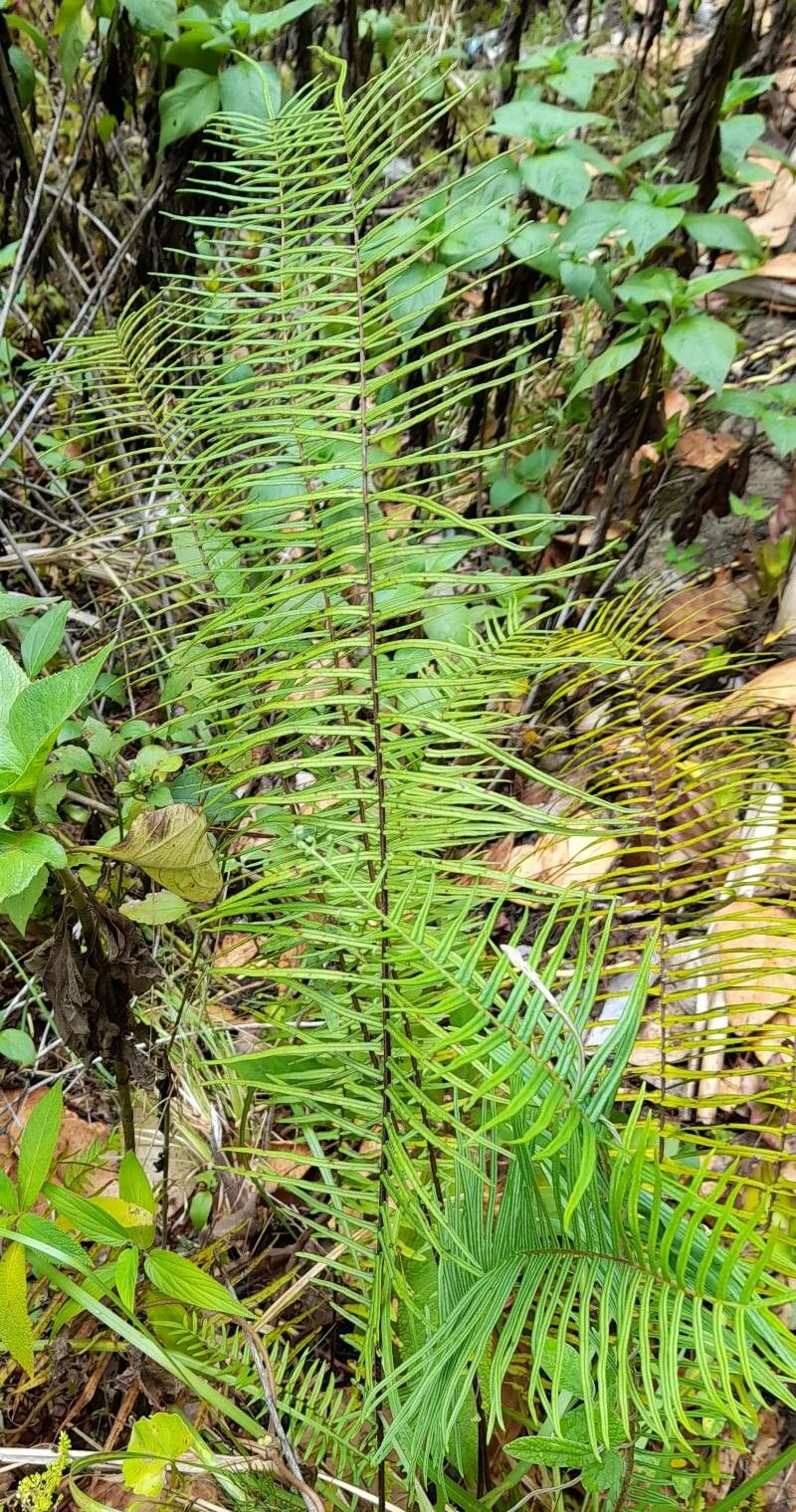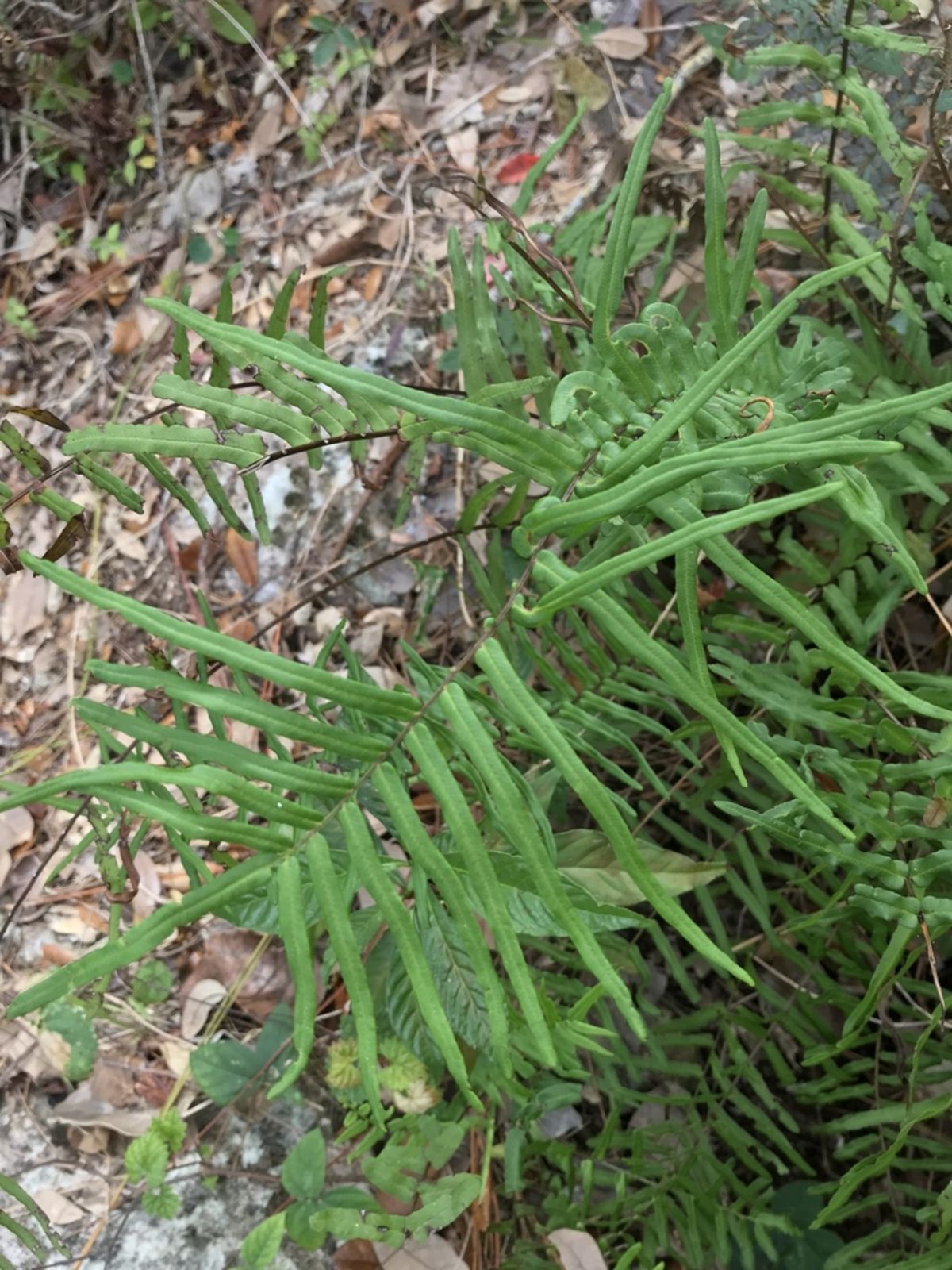Longfern
pteris longifolia
Also known as: ["Longfern","Long-leaved brakefern"]
Overview
A species of fern with long, narrow fronds, native to tropical regions.
Benefits & Perks
["shade tolerant","aesthetic foliage","wildlife attractant (bees, butterflies, birds)"]
Botanical Classification
| Phylum: | Tracheophyta |
| Class: | Polypodiopsida |
| Order: | Pteridales |
| Family: | Pteridaceae |
| Genus: | Pteris |
| Botanical Name: | Pteris longifolia |
Plant Characteristics
Basic Information
- Category: Leaf Plants
- Suitable Location: indoor pot in a humid room with indirect light
- Suitable For:
- Is Weed: No
- Allergenicity: low
Environmental Needs
- Climate: {"temperatureRange":"10–27°C"}
- Hardiness: {"zones":"9–11"}
- Misting: every 2–3 days, especially in dry indoor environments
- Drainage: Fast-draining to prevent waterlogging.
- Soil Type: Well-draining, rich, organic soil with peat moss or compost.
Maintenance Level
- Maintenance Level: moderate
- Toughness Level: moderate
- Pruning Frequency: As needed, typically every few months or after flowering.
- Pruning Intensity: Light to moderate; remove only damaged or unsightly fronds.
Care Details
Ideal Sunlight Coverage:
Bright indirect light for 6–8 hours daily; adjust to lower light in winter to prevent scorching.
Sunlight Tolerance Tips:
Acclimate the plant gradually to new light conditions; avoid direct sunlight to prevent leaf burn; place in a shaded spot outdoors if moving from indoors.
Care Requirements
Care Difficulty
easymoderate
Sunlight
partial shade to filtered light
Rotate the plant weekly for even growth; use sheer curtains to filter intense light; avoid placing near south-facing windows in summer.
Watering
every 7–10 days, allowing soil to dry slightly between waterings
Keep soil consistently moist but not waterlogged; avoid letting the plant sit in water; ensure good drainage.
Soil
well-draining, peat-based potting mix
pH: Slightly acidic to neutral (pH 5.5–7.0).
Ensure pots have drainage holes; avoid heavy clay soils; test pH periodically.
Temperature
Prefers 60–75°F (15–24°C); tolerates a range of 50–80°F (10–27°C) with moderate humidity.
Avoid placing near heating/cooling vents; maintain stable temperatures; monitor for signs of stress.
Fertilizing
every 4–6 weeks during active growth (spring and summer)
Apply fertilizer after watering to prevent root burn; flush soil occasionally to remove buildup; avoid overfertilizing.
Propagation
Methods
Division of rhizomes or spores from mature fronds.
Step-by-Step Propagation Guide
- For divisions: carefully separate rhizomes with roots.
- For spores: collect and sow on sterile medium.
- Keep consistently moist.
Best Time: Spring or early summer when the plant is actively growing.
Environment
High humidity (70–90%), warm temperatures (65–75°F), and indirect light.
Medium
Peat-based mix with perlite or sphagnum moss for spores; well-draining soil for divisions.
Hormone
Not necessary for divisions; optional for spores to encourage germination.
Timeline
Spores may take 1–3 months to germinate; divisions establish within 2–4 weeks.
Tools Needed
Sharp, sterile knife or shears, spore collection kit, humidity dome or plastic bag.
Quick Tips
Use clean tools to prevent disease; maintain high humidity for spores; be patient with germination.
Pruning & Repotting
Pruning Guide
Method
Cut fronds at the base with clean, sharp tools; avoid cutting into healthy tissue.
Pruning Plan
Remove dead or damaged fronds to maintain appearance and health; encourage new growth.
Tools
Pruning shears, scissors, or a sharp knife.
Checklist
Sterilize tools before use; cut cleanly at the base; dispose of removed fronds properly.
Repotting Guide
Best Season
Spring, before the active growing season begins.
Pot Size
Choose a pot 1–2 inches larger in diameter than the current one.
Method
Remove plant gently, trim roots if necessary, place in a new pot with fresh soil, and water lightly.
Suggestions
Repot every 2–3 years or when roots fill the pot; beneficial for growth and soil refreshment.
Checklist
Prepare new pot with drainage holes; use fresh, well-draining soil; water sparingly after repotting.
Advanced Care Tips
Watering Mastery
Watering Checklist
Check soil moisture before watering; water until it drains from the bottom; discard excess water from the saucer.
How to Apply Water Properly
Water slowly and deeply at the base of the plant, ensuring moisture reaches the root zone; allow excess water to drain away completely; water in the morning to reduce evaporation and fungal risk.
Watering Schedule Tips
Water thoroughly when the top inch of soil feels dry; reduce frequency in winter to prevent root rot.
Soil Improvement
Add perlite or coarse sand for drainage; incorporate organic matter like compost for fertility.
Temperature Stress Management
Signs of Temperature Issues
Yellowing or browning leaf tips; stunted growth; wilting despite adequate water.
Cold Stress
Slows growth and can cause leaf discoloration or necrosis; may enter dormancy if temperatures drop below 50°F (10°C).
Solution: Move to a warmer location; insulate the pot with bubble wrap if outdoors; avoid cold drafts.
Hot Stress
Leaves may curl, wilt, or develop brown spots; increased water loss can lead to dehydration.
Solution: Increase humidity with misting or a pebble tray; provide shade during peak heat; water more frequently but avoid overwatering.
Fertilizing Guide
Fertilizing Checklist
Check fertilizer label for NPK ratio; dilute correctly; apply during active growth; stop in dormant periods.
Fertilizing Method
Use a balanced liquid fertilizer diluted to half strength every 4–6 weeks during growing season (spring/summer); cease in fall/winter.
Common Problems & Solutions
Toxicity Warning
Cats
Non-toxicPteris longifolia is not known to be toxic to cats. There are no documented cases of adverse effects from ingestion or contact with this plant.
⚡ Toxic If:
Generally non-toxic
Dogs
Non-toxicPteris longifolia is not known to be toxic to dogs. There are no documented cases of adverse effects from ingestion or contact with this plant.
⚡ Toxic If:
Generally non-toxic
Humans
Non-toxicPteris longifolia is not known to exhibit toxic properties to humans under normal circumstances. It is generally considered safe for handling and presence in living environments.
⚡ Toxic If:
Generally non-toxic
Frequently Asked Questions
Q: How often should I water Pteris longifolia?
A: Water when the top inch of soil feels dry, typically once a week.
Q: Does Pteris longifolia need direct sunlight?
A: No, it prefers indirect or filtered light and can thrive in shaded areas.
Q: Is Pteris longifolia toxic to pets?
A: No, it is non-toxic to dogs and cats.
Quick Reference
| Family: | Pteridaceae |
| Care: | easy |
| Light: | partial shade to filtered ligh |
| Water: | every 7–10 days, allowing so |
Get Expert Care Tips
Download the Plantious app for personalized care reminders and plant identification!
Google Play App Store








